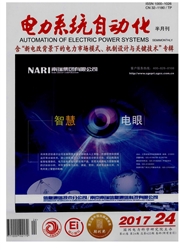

 中文摘要:
中文摘要:
不对称三相电压下,电压源型换流器(VSC)将产生低次谐波,给电网造成谐波污染。随着VSC在电力系统中的广泛应用,这类问题必须得到更多的关注,提出有效的解决方法。基于动态相量和序分量,推导出序分量动态相量,并对其特性进行了分析;将含开关函数描述的VSC时域模型转化为动态相量模型;定义交流电流和直流电压的各阶序分量动态相量为状态变量,建立了以状态空间描述的VSC序分量动态相量谐波分析模型,综合考虑了开关函数的详细动态特性和交直流侧谐波的相互作用,从而揭示了 VSC 产生谐波的机理,实现了 VSC 谐波的解析求解。在此基础上,提出负序补偿的不对称调制策略,以抑制低次谐波的产生。通过各种不对称情况下的仿真和计算,验证了所提出的谐波分析模型的正确性和谐波抑制策略的有效性。
 英文摘要:
英文摘要:
A voltage source converter (VSC) will generate low-order harmonics under unbalanced three-phase voltage causing harmonic pollution to power grids.With the wide application of VSCs in power systems,the harmonic pollution must be eliminated and given more attention by finding effective solutions.Based on dynamic phasors and symmetrical components,the sequence dynamic phasor is deduced and its characteristics are analyzed.The time domain VSC model containing a description of switching function is transformed into a dynamic phasor model.By setting the sequence dynamic phasors of AC current and DC voltage as the state variables,a harmonic analysis model in the state space based on the sequence dynamic phasors of VSC is developed.The model considers both the dynamic performance of power electronic devices and the interaction between AC and DC sides thus revealing the mechanism of how VSC generates harmonics.Based on the model,the harmonics generated by VSC can be calculated analytically.A harmonic elimination strategy with an unbalanced modulation to compensate the negative sequence voltage is proposed.Simulation results under various unbalanced conditions verify the correctness of the model and the effectiveness of the elimination strategy.
 同期刊论文项目
同期刊论文项目
 同项目期刊论文
同项目期刊论文
 期刊信息
期刊信息
